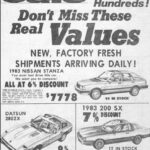The current car market is experiencing a curious phenomenon: a growing reluctance among consumers to buy new vehicles. This isn’t just about affordability; many believe today’s new cars are inferior to their predecessors. While used car prices have begun to fall, making them an attractive option, there’s a deeper sentiment at play. More and more, potential buyers are questioning the value proposition of the latest models.
The Allure of the Used Car Market
Savvy buyers are capitalizing on depreciated vehicle values, opting for used or off-lease cars and trucks still under warranty. This financially sound approach allows them to acquire reliable transportation at significantly lower prices than new models. However, this practical consideration is only part of the story. A growing number of consumers are actively rejecting new cars based on perceived shortcomings in design and technology.
Perceived Inferiority of New Vehicles
A significant portion of potential buyers believe that automakers’ current offerings, regardless of powertrain (gasoline, electric, or hybrid), are simply not as good as the models they replace. This sentiment transcends brand loyalty and encompasses a wide range of concerns.
Technophobia and the Fear of the Unknown
Some consumers express anxieties about the increasing digital connectivity of modern vehicles. Concerns range from data privacy and potential vulnerabilities to hacking, to fears of personal information being shared with insurance companies or even foreign governments.
Unpopular Technological Advancements
Several widely adopted technologies are also fueling the aversion to new cars. Features like stop/start systems (designed to improve fuel efficiency), continuously variable transmissions (CVTs), and diesel exhaust fluid (DEF) systems are often cited as undesirable additions. Many drivers find these technologies intrusive or unreliable, preferring the simpler mechanics of older vehicles.
The Loss of Beloved Features
The disappearance of certain beloved features from new cars further contributes to the problem. Manual transmissions, for example, are becoming increasingly rare, much to the chagrin of driving enthusiasts. Similarly, the phasing out of built-in CD players is a source of frustration for many.
The Touchscreen Dilemma
Perhaps the most common complaint about new cars centers around the ubiquitous touchscreen interface. The replacement of physical buttons and knobs with virtual controls within complex menu systems has proven to be a major source of frustration for many drivers. Critics argue that these systems are distracting, unintuitive, and less reliable than traditional controls. This sentiment is echoed by Brock Yates Jr., organizer of the One Lap of America road race, who observes that new vehicles are “overladen with intrusive nannies and technologies designed for the lowest level of unskilled and distracted drivers.”
Conclusion
The trend of rejecting new cars reflects a complex interplay of factors, from economic considerations to concerns about technology and the loss of familiar features. While the allure of lower prices in the used car market is undeniable, a significant driver of this trend is the perception that new cars are over-engineered, less reliable, and less enjoyable to drive than their predecessors. The automotive industry faces a challenge in addressing these concerns and regaining the trust of a growing segment of skeptical consumers.


